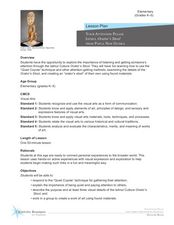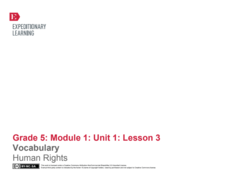Curated OER
Adverbs
Fifth graders complete a worksheet where they must fill in the blanks with the correct adverb. In this language arts lesson, 5th graders learn all about adverbs and when and where to use them. Students cut action pictures out of a...
Curated OER
Narrative Writing-10 Strategies for Engaging the Reader
Fifth graders discuss what narrative writing represents. For this language arts lesson, 5th graders review the ten strategies for engaging reader. Students listen to and read good examples of each strategyand write engaging beginnings in...
Curated OER
Reading-Author's Purpose
Students review what author's purpose is by understanding that authors either persuade, inform, describe, or entertain with their story. In this language arts instructional activity, students bring in junk mail and in small groups...
Curated OER
Commas
Fifth graders discuss when a comma is necessary in a sentence. In this language arts lesson, 5th graders understand that commas are used as a pause and help the reader understand ideas better. Students find an example of each example...
Curated OER
Figurative Language
Students create a PowerPoint show illustrating two types of figurative language. They demonstrate understanding of personification by creating and interpreting simple examples. They also demonstrate understanding of alliteration.
Curated OER
Poetry Scrap Book
After your poets have compiled several written poems into a scrap-book, use this grading scale to explain how they'll be graded. The only guiding explanation of the assignment explains that they need to use two of the five literary...
Curated OER
California Artists
Fifth graders identify and compare works of art from various regions of the United States. Telecollaborative partners, from different states, work together to complete this assignment. Using the internet, 5th graders research a specific...
Curated OER
Say Hello! Around the World
Hello! Bonjour! Paivaa! Ni hao! Teach learners of all ages how to say hello in several different languages. There are project ideas for younger learners and older learners. Kids love learning a different language, even if it's just this...
Curated OER
Fairy Dictionary
Use artwork to illicit responses in a writing journal, and then present your class with the short list of key terms provided. Can your learners add any of their own key terms? Segue for a second, and read tales such as Peter Pan or...
Curated OER
Dictionary Skills Review
Elementary and middle schoolers write 12 words in alphabetical order. They answer seven questions using the dictionary skills of pronunciation, breaking words into syllables and finding definitions. Then they answer five questions about...
Curated OER
Finding My Voice
Have your class learn the essentials of public speaking. They compose a speech for their fifth grade celebration using iPods and presentation software. This would be a great end of the year activity for any grade level.
Curated OER
Creature Feature Poetry Keyword Search!
Young scholars examine the differences between fact and opinion, and brainstorm ideas for a keyword list by analyzing facts. They listen to poems, and create posters listing three keywords about each creature featured in the poetry.
Curated OER
Children's Literature Across the Curriculum Ideas-How Dogs Really Work!
Students read How Dogs Really Work! by Alan Snow. They complete a variety of cross-curricular activities surrounding the study of dogs as pets. Included are reading, art, math, science, writing, social studies, and library connections.
Curated OER
Parts-of-Speech Tall Tales
Here is a lesson that can work for virtually any grade level! Pupils study parts of speech such as nouns, verbs, adjectives, proper nouns, and adverbs. They create fill in the blank tall tails on a web page for their classmates to complete.
Curated OER
Your Attention Please: Iatmul Orator's Stool
Learners investigate art by observing historical sculptures from New Guinea. For this art history lesson, students observe pictures of the "Orator's Stool"from Papua New Guinea, while identifying the small details that make it unique....
Curated OER
Native American Clay Pots
Students explore world culture by conducting an art project in class. In this Native American culture lesson plan, students identify the types of materials American Indians utilized in their artistic endeavors, specifically clay....
Curated OER
Writing About Time: My Favorite Times
Start by clicking on the icon that says, "Download the Activity." The format is much easier to read and understand here! Then, encourage your class to write about some of their favorite things through a three-paragraph essay. Examples...
Curated OER
"One-Minute Monologue" Builds Communication Skills
Get everyone talking! It's rare that a lesson can potentially span from third to twelfth grade, but this one really can! Get two paper bags. Fill one with the names of each learner, and fill the other with random topics you brainstorm....
LearnEnglishFeelGood.com
Gerund or Infinitive?
Decide which form of the verb to use in ten sentences. Young grammarians watch for context clues when determining if they should use gerunds or infinitives in the blank spaces of each sentence.
EngageNY
Getting to Know Esperanza (Chapter 2: “Las Uvas/Grapes”)
Delve into Esperanza Rising by Pam Muñoz Ryan with close reading and evidence-based, text-dependent questions. Part of a unit series, this well-sequenced, Common Core designed instructional activity draws on material from the previous...
EngageNY
Mid-Unit Assessment and Discussing Themes in Esperanza Rising: (Chapter 9: "Las Ciruelas/PLums")
Give this skills-based assessment halfway through your unit on Esperanza Rising. After a brief review, class members take the test, which asks them to show that they know how to analyze the novel independently. They are asked to...
EngageNY
Gathering Evidence and Drafting a Two-Voice Poem (Chapter 13: "Los Duraznos/Peaches")
Begin class with a short comprehension quiz and review and then move into a new genre: two-voice poems. The activity provides information about this type of poetry as well as a video example made by eighth graders that you can show your...
EngageNY
Vocabulary: Human Rights
Your class continues to explore the history of the Universal Declaration of Human Rights. In addition to learning about the background of this text, learners work on the skill of identifying and understanding key academic vocabulary....
EngageNY
Main Ideas in Informational Text: Analyzing a Firsthand Human Rights Account
Although this is part of a series, lesson plan nine has your class take a break from their close study of the Universal Declaration of Human Rights (UDHR) text to read the firsthand account “Teaching Nepalis to Read, Plant, and Vote” by...

























